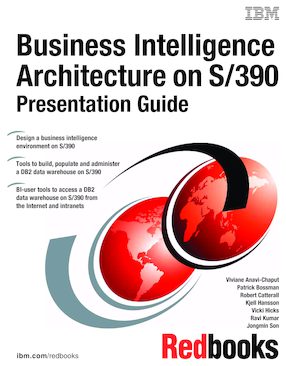Business Intelligence Architecture on S/390 Presentation Guide
An IBM Redbooks publication
Note: This is publication is now archived. For reference only.

Published on 02 August 2000
ISBN-10: 0738417521
ISBN-13: 9780738417523
IBM Form #: SG24-5641-00
Authors: Viviane Anavi-Chaput, Patrick Bossman, Robert Catterall, Kjell Hansson, Vicki Hicks, Ravi Kumar and Jongmin Son
This IBM Redbooks publication presents a comprehensive overview of the building blocks of a business intelligence infrastructure on S/390.
It describes how to architect and configure a S/390 data warehouse, and explains the issues behind separating the data warehouse from or integrating it with your operational environment.
This book also discusses physical database design issues to help you achieve high performance in query processing. It shows you how to design and optimize the extract/transformation/load (ETL) processes that populate and refresh data in the warehouse. Tools and techniques for simple, flexible, and efficient development, maintenance, and administration of your data warehouse are described.
The book includes an overview of the interfaces and middleware services needed to connect end users, including Web users, to the data warehouse. It also describes a number of end-user BI tools that interoperate with S/390, including query and reporting tools, OLAP tools, tools for data mining, and complete packaged application solutions.
A discussion of workload management issues, including the capability of the OS/390 Workload Manager to respond to complex business requirements, is included. Data warehouse workload trends are described, along with an explanation of the scalability factors of the S/390 that make it an ideal platform on which to build your business intelligence applications.
Ch. 1 - Introduction to BI architecture on S/390
Ch. 2 - Data warehouse architectures and configurations
Ch. 3 - S/390 data warehouse database design
Ch. 4 - Data warehouse data population design
Ch. 5 - Data warehouse administration tools
Ch. 6 - Access enablers and web user connectivity
Ch. 7 - BI user tools interoperating with S/390
Ch. 8 - BI workload management
Ch. 9 - BI Scalability on S/390
Ch. 10 - Summary